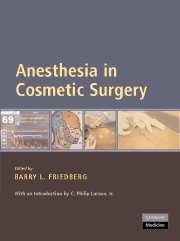Book contents
- Frontmatter
- Contents
- Foreword
- Acknowledgments
- Introduction
- Preface
- List of Contributors
- PART I MINIMALLY INVASIVE ANESTHESIA (MIA)Ⓡ FOR MINIMALLY INVASIVE SURGERY
- 1 Propofol Ketamine with Bispectral Index (BIS) Monitoring
- 2 Preoperative Instructions and Intraoperative Environment
- 3 Level-of-Consciousness Monitoring
- 4 The Dissociative Effect and Preemptive Analgesia
- 5 Special Needs of Cosmetic Dental Patients
- 6 Propofol Ketamine in the UK, Propofol Ketamine Beyond Cosmetic Surgery
- 7 Propofol Ketamine Beyond Cosmetic Surgery: Implications for Military Medicine and Mass-Casualty Anesthesia
- 8 Lidocaine Use and Toxicity in Cosmetic Surgery
- 9 Local Anesthetic Blocks in Head and Neck Surgery
- 10 Local Anesthetics and Surgical Considerations for Body Contouring
- PART II ALTERNATIVE ANESTHESIA APPROACHES IN COSMETIC SURGERY
- PART III OTHER CONSIDERATIONS FOR ANESTHESIA IN COSMETIC SURGERY
- APPENDIX A A Guide to Perioperative Nutrition
- APPENDIX B Reflections on Thirty Years as an Expert Witness
- Index
- References
2 - Preoperative Instructions and Intraoperative Environment
from PART I - MINIMALLY INVASIVE ANESTHESIA (MIA)Ⓡ FOR MINIMALLY INVASIVE SURGERY
Published online by Cambridge University Press: 22 August 2009
- Frontmatter
- Contents
- Foreword
- Acknowledgments
- Introduction
- Preface
- List of Contributors
- PART I MINIMALLY INVASIVE ANESTHESIA (MIA)Ⓡ FOR MINIMALLY INVASIVE SURGERY
- 1 Propofol Ketamine with Bispectral Index (BIS) Monitoring
- 2 Preoperative Instructions and Intraoperative Environment
- 3 Level-of-Consciousness Monitoring
- 4 The Dissociative Effect and Preemptive Analgesia
- 5 Special Needs of Cosmetic Dental Patients
- 6 Propofol Ketamine in the UK, Propofol Ketamine Beyond Cosmetic Surgery
- 7 Propofol Ketamine Beyond Cosmetic Surgery: Implications for Military Medicine and Mass-Casualty Anesthesia
- 8 Lidocaine Use and Toxicity in Cosmetic Surgery
- 9 Local Anesthetic Blocks in Head and Neck Surgery
- 10 Local Anesthetics and Surgical Considerations for Body Contouring
- PART II ALTERNATIVE ANESTHESIA APPROACHES IN COSMETIC SURGERY
- PART III OTHER CONSIDERATIONS FOR ANESTHESIA IN COSMETIC SURGERY
- APPENDIX A A Guide to Perioperative Nutrition
- APPENDIX B Reflections on Thirty Years as an Expert Witness
- Index
- References
Summary
PREOPERATIVE INSTRUCTIONS
Nothing per os (NPO), or nothing by mouth, after midnight is the most commonly given preoperative instruction to all surgical patients. This is not unreasonable given the fact that the majority of surgical patients are exposed to emetogenic inhalational vapors and/or emetogenic intravenous opioids. Both inhalational vapors and intravenous opioids depress the laryngeal or “life-protecting” reflexes.
California Assembly Bill (AB)595 specifically mandated office accreditation when sedatives and analgesics are used in a manner that has the probability to depress the “life-preserving” reflexes. The “Catch-22” is that neither the legislature nor the anesthesia community ever defined what the “life-preserving” reflexes are. In both the peer-reviewed literature1 and in unrebutted public testimony before theCAMedical Board when Dr. Thomas Joas, a prominent anesthesiologist, was its presiding chairman, Friedberg has unequivocally defined the laryngeal reflexes as the “life-preserving” reflexes.
Emetogenic inhalational vapors and/or emetogenic intravenous opioids expose the surgical patient to an increased likelihood of aspiration and death. If surgical patients cannot reflexly protect their trachea, they cannot preserve their lives. The lack of pharyngeal reflexes or swallowing seen with propofol sedation/anesthesia does not necessarily mean that the laryngeal reflexes are similarly depressed. In fact, when ketamine is added to the regimen of propofol sedation and opioids are scrupulously avoided (i.e., PK MAC/MIA™ technique), laryngospasm has been observed in about 1–2% of patients. Laryngospasm is the antithesis of depressed laryngeal reflexes.
- Type
- Chapter
- Information
- Anesthesia in Cosmetic Surgery , pp. 14 - 22Publisher: Cambridge University PressPrint publication year: 2007



